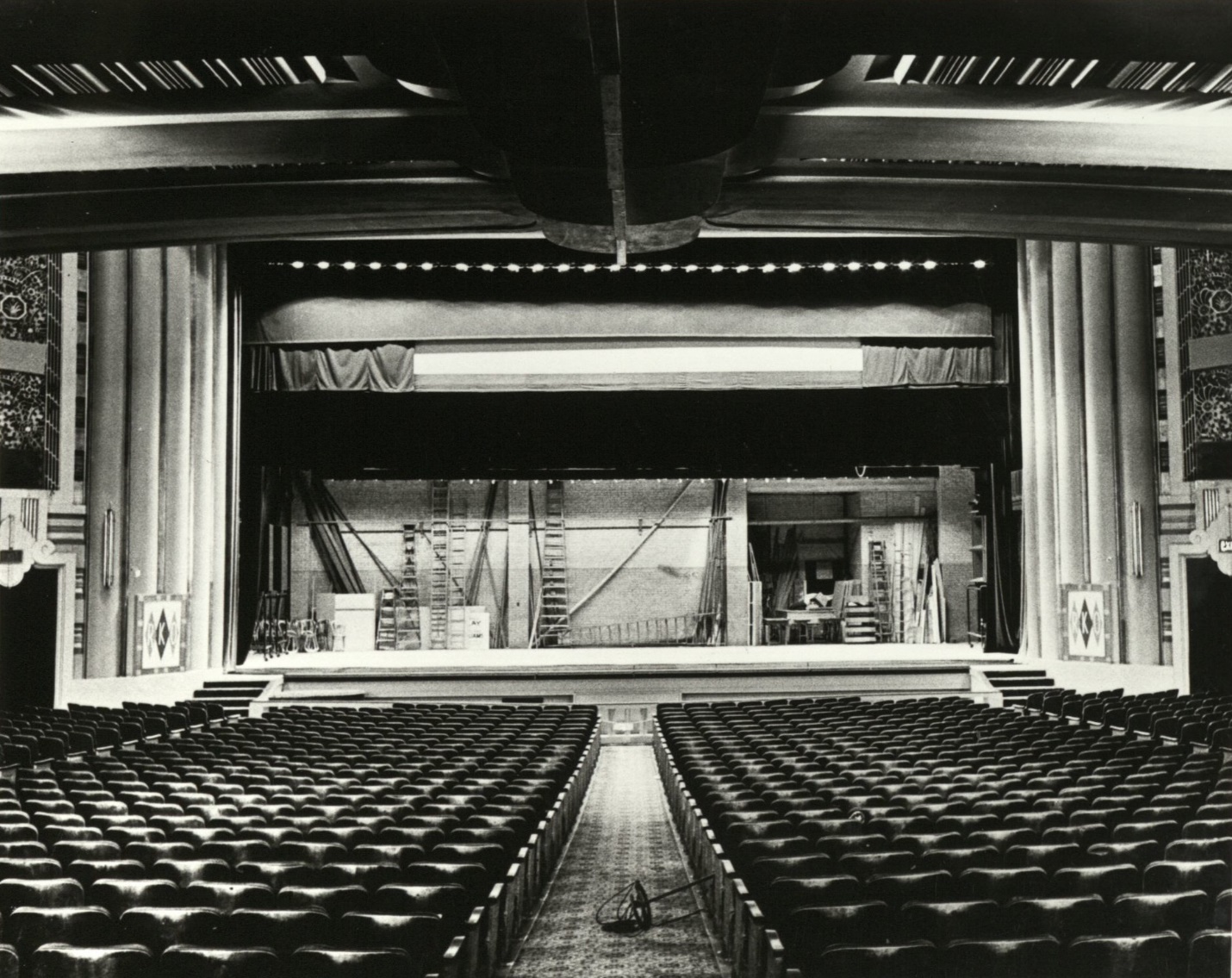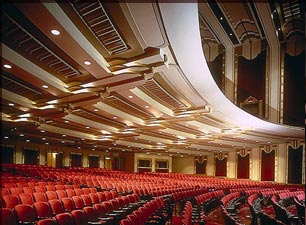Henry Dreyfuss and Adler Theater Member Tour
The Henry Dreyfuss and Adler Theater member tour was cancelled due to COVID-19, but tour-guide, Wynne Schaefer, is sharing some highlights with Figge members about what would have been covered during this exclusive members-only tour.
The exhibition, Henry Dreyfuss: Designs for the Modern Age, opened in February 2020 and served as the inspiration for the tour. Dreyfuss was the designer of the Adler Theater, a beautiful Art Deco landmark in downtown Davenport. This local connection was the perfect opportunity for Figge members to experience a more in-depth view of his work beyond the pieces in the exhibition.
(Adler Theater original stage)
 The 1920-30 period in downtown Davenport brought massive changes to the center city. Two and three story buildings occupied most of the area. You can still see a few remaining examples on the east side of Brady just south of 3rd St and north of 3rd on Main. The first buildings constructed were the Blackhawk Hotel 1915-20, the Kahl building 1920 and the American Savings Bank 1927. Following tradition, these buildings were designed to express the wealth, power and success of the owners as well as invest in the future of their hometown.
The 1920-30 period in downtown Davenport brought massive changes to the center city. Two and three story buildings occupied most of the area. You can still see a few remaining examples on the east side of Brady just south of 3rd St and north of 3rd on Main. The first buildings constructed were the Blackhawk Hotel 1915-20, the Kahl building 1920 and the American Savings Bank 1927. Following tradition, these buildings were designed to express the wealth, power and success of the owners as well as invest in the future of their hometown.
George Bechtel, owner of the First Trust and Savings Bank and founder of the Bechtel Trust built the Mississippi Hotel starting in 1928. The hotel had 200 rooms and 50 apartments with an attached theater. The theater was a part of the Radio-Keith-Orpheum circuit, which operated theaters all across the country. The hotel complex was the last project completed in the Davenport downtown as the Depression rolled in 1930. Schaefer likes to call the Mississippi Hotel project the "Empire State Building of Davenport" as it also was the last building built in Manhattan.
The hotel was designed by Chicago Architect A.W.Graven. The exterior shows a simplified classical design with stylized floral elements accenting the windows vertical shaft. It was probably the most Modern building downtown using a simple Art Deco style. It's hard to know how much the impact of the economic down turn has on the exterior. The interior lobby remains intact with beautiful bronze elevators and mahogany stairway and paneling.
Henry Dreyfuss was a well-known successful Broadway set designer. At the time he was working for Norman Bel Geddes, a brilliant set designer and early industrial designer. Bel Geddes worked for Hollywood studios as well as Broadway. Henry was contracted to design for RKO which started in Vaudeville and moved to motion pictures. Henry understood the theater business. He designed over 500 sets a year in New York and worked with producers and performers successfully.
 The Davenport RKO, Adler Theater (pictured on the right), was special in a couple ways. It was the first theater with a single person controlling the design. Usually vendors were given the selection task for the carpet, seating, and the architect would select the finishes. Dreyfuss had all selection control so the design was unified showing repetition of motifs, materials and character of the elements. The style was a geometric stylized Art Deco using bas relief floral designs, simple geometric moldings and sophisticated colors and materials. This was also one of the last projects for Dreyfuss before he struck out in his own firm in 1929.
The Davenport RKO, Adler Theater (pictured on the right), was special in a couple ways. It was the first theater with a single person controlling the design. Usually vendors were given the selection task for the carpet, seating, and the architect would select the finishes. Dreyfuss had all selection control so the design was unified showing repetition of motifs, materials and character of the elements. The style was a geometric stylized Art Deco using bas relief floral designs, simple geometric moldings and sophisticated colors and materials. This was also one of the last projects for Dreyfuss before he struck out in his own firm in 1929.
The day of the opening of the RKO was started with a noon day parade. Flowers were sent from Ginger Roger's garden. Big executives were in town. Search lights filled the sky on the evening of November 25, 1931. It was the opening of the RKO Orpheum Theater in the Mississippi Hotel Building on East Third Street. At 6:30 a packed house enjoyed the festivities with speeches and two shows that night. Five live vaudeville acts and the first movie to be shown was "Suicide Fleet" with Ginger Rogers, William Boyd and Robert Armstrong.
The theater boasted of flawless acoustics, modern climate control and first class projection equipment. The theater was very popular until the move out the central downtown was fashionable. The theater close in April of 1973.
The Restoration of the Adler in 1986, returned the theater to its original glory. Improved lighting, sound system, refurbished seating were installed but the decorative elements of Dreyfuss designs remained intact. The tempered Art Deco style used simple geometric elements and stylized floral patterns. Elegance was added through a selection of sumptuous materials, moiré' wallpapers and rich upholstery. The quality of Henry Dreyfuss design stood the test of time. The theater remains a community treasure.
(Original concession area) (Tray Ceiling details) (Stylized in the Art Deco manner)



(Detail of end panel of theater seats) (Rounded stepped motifs mimic skyscraper (Original signage)
shapes in Manhattan)



(Original seating) (Elegant ceiling fixtures in lobby and balcony) (Original colors and marble)



(Original handrails and carpet) Original bas relief is intact in lower lobby


(Original view of the entry to Adler) (Restored lobby in 1986. Carpet and lighting matched original)


(Restoration of the Adler in 1986 returned the theater to original glory)

Take an online tour of the Henry Dreyfuss: Designs for the Modern Age exhibition.




